Selecting Safe Reputable Adult Websites
Get steps to pick safe adult websites by checking security protocols, reading user feedback, and confirming site reputation for better protection.
Ways to Find and Choose Reputable Secure Adult Web Resources
Verify HTTPS indicators on any platform offering mature materials first; this confirms data protection during interactions. Check user feedback from reliable forums to gauge platform credibility before engaging. Focus on platforms with clear age verification processes, such as ID checks, to avoid unintended exposure.
Examine developer details and contact information listed on the site; legitimate ones provide verifiable company data. Opt for platforms that regularly update content delivery systems, reducing risks from outdated software. Integrate a VPN tool when browsing to mask your IP and enhance privacy layers.
Seek platforms with community ratings above 4 stars on neutral review aggregators; these often indicate fewer issues. Prioritize those with explicit consent policies for user uploads, ensuring ethical standards. Always maintain separate accounts for such platforms to segregate personal online activities.
Checking for Encryption and Privacy Policies
Examine URLs for the HTTPS prefix to confirm encrypted data transmission, and verify the padlock icon in the browser bar for active secure connections.
Assessing Secure Connections
Test SSL certificates using free analyzers like SSL Labs; ensure they are valid, porn russian not expired, and issued by recognized authorities to prevent interception risks.
Evaluating Data Handling Statements
Identify the policy document via footer links; scrutinize sections on data gathering methods, retention periods, and third-party disclosures for potential vulnerabilities. Focus on opt-out mechanisms and explicit consent requirements to gauge user control over information.
Researching Site History and User Feedback
Verify domain age using WhoIs tools, focusing on registration dates and ownership changes for signs of stability.
Scan archived versions via the Wayback Machine to spot content alterations or sudden site redesigns indicating potential concerns.
Collect opinions from Reddit threads or similar discussion boards, prioritizing detailed accounts over brief posts for reliable patterns.
Analyze ratings on platforms like Trustpilot, noting complaint frequencies about access issues or misleading content.
Cross-reference feedback with site policies, such as privacy statements, to confirm alignment with user experiences shared online.
Verifying Age Restrictions and Legal Compliance
Examine site policies for explicit age limits, such as 18+ or 21+ markers, before access.
- Review local regulations like the Children’s Online Privacy Protection Act (COPPA) in the US or General Data Protection Regulation (GDPR) in Europe to confirm user data handling aligns with protections for minors.
- Seek evidence of age checks, including ID verification tools or third-party services that confirm user eligibility through secure methods.
- Test site features for automatic restrictions, such as pop-ups demanding date of birth or location-based blocks to prevent underage entry.
Consult legal resources, including government sites or industry standards, to cross-reference compliance with current statutes on content access.
- Analyze user agreements for clauses detailing age requirements and consequences of violations.
- Monitor for updates through official channels, ensuring practices adapt to new rules from authorities.
- Engage experts for audits if uncertainty arises about adherence to international norms.




